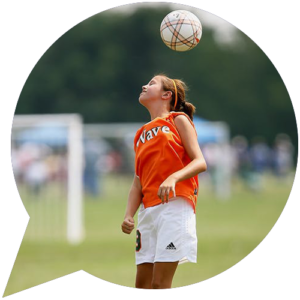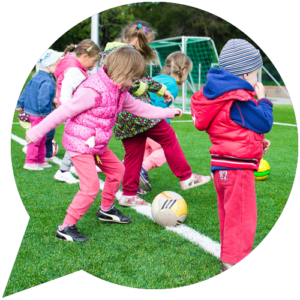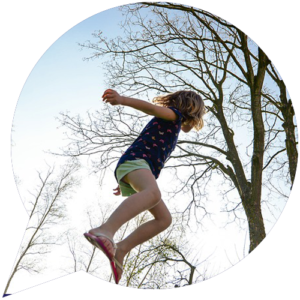Physical Activity
The Importance of Physical Activity

1. Enhancing concentration in the classroom

2. Improving health and fitness including strong bones and good muscle strength

3. Enhancing mental and social well-being and overall enjoyment of life

4. Decreasing risk factors for chronic diseases
How much do kids need to huff and puff?
Australian activity guidelines for children of different ages:
0-1 year: some physical activity, such as floor play, each day
1-5 years: at least three hours of activity spread across the day
5-18 years: at least one hour of moderate (e.g. walking the dog) to vigorous (e.g. running or playing netball) physical activity each day.
Physical activity doesn’t have to be done all at once, it can be enjoyed in small blocks of time throughout the day. Not all kids enjoy organised sport so it is important to think creatively and help them find other ways to stay active. The most important thing is to find a variety of activities that they enjoy doing.
Parents’ Voice helps shape the places children live and play to support and promote physical activity.
Take Action: We’d love to hear about how your family, local government, school or sports club are promoting activity or reducing inactivity in fun and interesting ways. Send us a video, pic or email so your story can inspire others.
Take Action: Encourage your child’s school to get involved with an Active transport program or get some parents together to set up an active transport group.
Organised Sport
Organised sport is a great way for children to get involved in regular physical activity but it is also so much more than that. It provides children with opportunities to socialise, to make new friends, and improves their self-esteem and confidence.
According to the Australian Bureau of Statistics, over 60% of all Australian children participate in at least one sporting activity outside of school hours.
Australian kids are fortunate to have a wide variety of sports to choose from. To explore the range of sporting activities available for children in your area, search the Australian Sports Directory online for contact details of all Australian sporting organisations.
Active Play
Active play is all about fun and it is a non-competitive alternative to organised sports. Ideally active play should be initiated by your kids but sometimes they might need a little prompting.
Parents on active play
- Take family walks in the bush, the park, by a local river or at the beach- kids will find a way to turn these walks into an adventure.
- Play outside on bikes, running around, climbing trees and playing with the dog. Encourage your children to take the dog for a walk every day.
- Have a picnic and take a bat and ball, frisbee, kite or a cricket set with you and play a game with your children. Invite some friends to make it even more fun.
- Help your children learn a new active skill such as hula hooping, skipping or cartwheels
- Start a veggie patch and get the whole family working in the garden. Young children love to plant, nurture, pick and then help cook their own veggies.
- Set up soccer goals in the garden and let the kids kick a ball around in a non-competitive manor.
Screen Time
What is screen time?
There are lots of different types of recreational screen time including watching TV, playing video games, surfing the net and using phones and apps. There is also educational screen time that may be spent researching and completing school work.
Recreational screen time becomes problematic when it takes the place of active play or organised sport. Too much sedentary behaviour can contribute to weight gain and detract from the overall health and wellbeing of children. Recreational screen time also increases children’s exposure to unhealthy food and drink advertisements and is associated increased snaking.
How much screen time is too much?
Determining how much screen time is too much for your child can be tricky. It’s about finding a balance between active time and sedentary time and this will be slightly different for each child. Some would argue the current Australian guidelines are unrealistically low however they do highlight the need for there to be limitations on screen time. As a general rule of thumb, the younger the child the less screen time they should have.
Australian recreational screen time guidelines
- 5 – 18 year olds accumulate no more than 2 hours of screen time for entertainment purposes
- 2 – 5 year olds accumulate no more than 1 hour of screen time
- Children younger than two years old do not spend any time viewing TV or other electronic media
Parents on reducing screen time
- Install a shut-down timer on younger children’s computers that limits the amount of time they can spend on it.
- Set a switch off time and stick to it.
- Designate certain days of the week as TV-free or computer-free days.
- Keep TVs and Computers in a part of the house where their use can be easily monitored – not in the bedroom.
- Control TV viewing by encouraging children to pick their schedule in advance rather than just sitting in front of the screen watching whatever is on.
- Help your children fill their time in other ways by suggesting play and active recreation ideas.
School Sport
There are plenty of opportunities within the school day for children to be active. The school environment should support and promote regular movement, physical activity and active play. Activity doesn’t need to be reserved for Physical Education (PE), it can be incorporated into any lesson.
Physical activity at school should:
- offer a variety of sports to appeal to a broad section of children
- include a mixture of competitive and non-competitive sports
- be a fun and positive experience
- be suitable for all ability levels
Schools should also place an emphasis on teaching young children fundamental movement skills. This will equip them with the essential skills they require to become proficient in other sports as they grow older.
Parents on school sports
“Check out the afterschool and weekend sport opportunities your school offers- I’ve found schools run programs offer a safe environment for children to play and be active outside school hours in a supervised environment.”
Support for schools
Our friends at Bluearth help schools and teachers to implement physical activity programs that are inclusive and enjoyable. They provide a comprehensive Teacher Resource Centre to support schools in making physical activity an important part of every school day. The Bluearth Program aligns with HPE curriculum for each state and territory and demonstrates how to include physical activity in other subject areas.
Active Transport
Active transport to and from school is a great way to include physical activity as a regular part of your child’s day. It is also helps kids arrive at school feeling alert and energised. Active transport methods include; walking, riding, skating or scooting. For some families it is not practical to use active transport to and from school every day but there are some great programs and events around Australia that help to make active transport safe, easy and fun for families.
Bicycle Network’s Ride2School Program
The Ride to School Program, which includes National Ride2School Day, aims to increase the number of Australian kids actively travelling to and from school all year round. The program helps schools and families to overcome barriers that might be preventing children from riding to school.
Walk Safely to School Day
Walk Safely to School Day is a national day that encourages all Primary School children to walk and commute safely to school. It’s a Community event that promotes road safety, health, public transport and the environment.
VicHealth walk to school campaign
Walk to school is a campaign that runs for the duration of term 4 in Victoria and helps primary school aged kids to develop healthy transport habits. As part of the campaign grants are offered to local governments to support and promote active transport.
Parents on active transport
“My son is at an age where he is seeking independence but is not quite old enough to walk to school without supervision so he walks ahead with his friends (and pretends he doesn’t know us) while my wife or I walk behind with our younger daughter.”
“I highly recommend Walking Maps. It’s an online service that enables schools, families and the communities across Australia to create maps of popular school walking routes.”
“Fit-bit or any similar activity trackers can be really motivating for kids and families. Our family has a challenge going on between parents and kids to see who can do the most steps in the day.”
